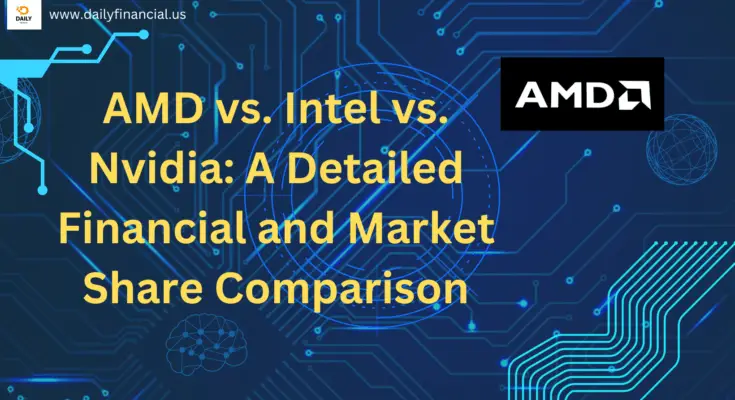Introduction
Advanced Micro Devices, Inc. (AMD) has been a significant player in the semiconductor industry, known for its innovative products and competitive edge against giants like Intel and Nvidia. This blog post examines into AMD’s current market position, financial health, and future growth predictions, providing a detailed analysis for investors and tech enthusiasts alike.
Latest News Highlights
Here are some of the latest news highlights about AMD:
- Advancing AI 2024 Event:
- AMD announced the “Advancing AI 2024” event, scheduled for October 10, 2024. This event will showcase the next-generation AMD Instinct™ accelerators and 5th Gen AMD EPYC™ server processors.
- Jim Cramer’s Take on AMD:
- Financial analyst Jim Cramer recently highlighted AMD as a “very cheap” stock, suggesting it is undervalued compared to its potential.
- Ryzen 7 7800X3D CPU Scam:
- A recent incident in Romania involved a scam with second-hand Ryzen 7 7800X3D processors. Buyers are advised to be cautious when purchasing CPUs from unreliable sources.
- Next-Gen “Zen 5” Ryzen Processors:
- AMD unveiled its next-gen “Zen 5” Ryzen processors at Computex 2024. These processors are designed to power advanced AI experiences and set new standards in efficiency and performance.
Latest Tie-Ups and Acquisition
Here are some of the latest tie-ups and acquisitions involving AMD:
1. Acquisition of Xilinx
- Overview: AMD completed its acquisition of Xilinx in early 2022. This strategic move aimed to create a high-performance and adaptive computing leader by combining AMD’s CPUs and GPUs with Xilinx’s FPGAs and adaptive SoCs.
- Impact: The acquisition expanded AMD’s product portfolio and market reach, particularly in data centers, AI, and embedded systems. It also increased AMD’s total addressable market (TAM) to approximately $135 billion.
2. Partnership with Microsoft for AI and Cloud Solutions
- Overview: AMD has strengthened its partnership with Microsoft to enhance AI and cloud computing solutions. This collaboration focuses on integrating AMD’s EPYC processors and Instinct accelerators into Microsoft’s Azure cloud platform.
- Impact: This partnership aims to provide high-performance computing solutions for AI workloads, benefiting both companies by leveraging AMD’s hardware capabilities and Microsoft’s cloud infrastructure.
3. Collaboration with Meta (Facebook)
- Overview: AMD has partnered with Meta to optimize its EPYC processors for Meta’s data centers. This collaboration focuses on improving performance and efficiency for Meta’s AI and machine learning workloads.
- Impact: The partnership enhances AMD’s presence in the data center market and supports Meta’s growing demand for high-performance computing solutions.
4. Acquisition of Pensando Systems
- Overview: In 2022, AMD acquired Pensando Systems, a company specializing in distributed services platforms. This acquisition aimed to bolster AMD’s data center and cloud offerings.
- Impact: Pensando’s technology complements AMD’s existing portfolio, providing advanced networking and security solutions for data centers.
5. Strategic Partnership with Samsung
- Overview: AMD has a strategic partnership with Samsung to integrate its RDNA graphics architecture into Samsung’s Exynos mobile processors.
- Impact: This collaboration aims to enhance the graphics performance of Samsung’s mobile devices, leveraging AMD’s expertise in GPU technology.
Company Overview
Founded in 1969, AMD has evolved from a second-source supplier of microchips to a leading designer of high-performance computing and graphics solutions. The company’s product portfolio includes CPUs, GPUs, and APUs, catering to various markets such as gaming, data centers, and embedded systems.
CEO and Chair:
Dr. Lisa Su: Dr. Lisa Su is the President, Chief Executive Officer (CEO), and Chair of AMD. She has been leading the company since October 2014 and became the Chair of the Board in February 2022. Under her leadership, AMD has seen significant growth and innovation, particularly in high-performance computing and graphics solutions.
Founder:
- Jerry Sanders: AMD was founded by Jerry Sanders along with seven others in 1969. Sanders served as the CEO of AMD until 2002.
Managing Director:
- AMD does not have a specific title of “Managing Director” in its current executive structure. The company is led by a team of senior executives, each responsible for different aspects of the business.
AMD’s Product Portfolio
AMD’s product portfolio from 2020 to 2023 has been diverse and innovative, covering a wide range of computing needs. Here’s a detailed look at their key product lines during this period:
1. CPUs (Central Processing Units)
- Ryzen Series: AMD’s Ryzen processors have been a significant success, particularly in the consumer market. The Ryzen 5000 series, based on the Zen 3 architecture, offered substantial performance improvements over previous generations. The Ryzen 7000 series, introduced in 2023, continued this trend with enhanced performance and efficiency.
- EPYC Series: Targeting the data center market, AMD’s EPYC processors have gained considerable traction. The 3rd Gen EPYC processors, codenamed “Milan,” and the 4th Gen EPYC processors, codenamed “Genoa,” have been well-received for their performance and scalability.
2. GPUs (Graphics Processing Units)
- Radeon RX Series: AMD’s Radeon RX 6000 series, based on the RDNA 2 architecture, competed strongly against Nvidia’s offerings. The Radeon RX 7000 series, launched in 2023, brought further improvements in gaming performance and power efficiency.
- Radeon Pro Series: These GPUs are designed for professional workloads, including content creation and CAD applications. The Radeon Pro W6000 series offered high performance for workstation users.
3. APUs (Accelerated Processing Units)
- Ryzen APUs: Combining CPU and GPU capabilities, Ryzen APUs have been popular in both desktop and mobile markets. The Ryzen 5000G series, based on Zen 3 and Vega graphics, provided excellent performance for integrated graphics solutions.
4. AI and Data Center Solutions
- Instinct MI Series: AMD’s Instinct MI100 and MI200 series GPUs are designed for AI and high-performance computing (HPC) workloads. These accelerators have been crucial in AMD’s strategy to capture the growing AI market.
- Adaptive Computing: Following the acquisition of Xilinx, AMD expanded its portfolio to include adaptive computing solutions like FPGAs (Field-Programmable Gate Arrays) and adaptive SoCs (System on Chips).
5. Embedded Solutions
- Ryzen Embedded: These processors are tailored for embedded applications, offering high performance and low power consumption. The Ryzen Embedded V2000 series, based on Zen 2 architecture, has been used in various industrial and commercial applications.
- EPYC Embedded: Designed for embedded servers and edge computing, the EPYC Embedded 3000 series provided robust performance and security features.
6. Software and Ecosystem
- AMD Software: AMD has also focused on enhancing its software ecosystem. The AMD ROCm (Radeon Open Compute) platform supports GPU computing, while the AMD Infinity Fabric technology improves interconnectivity between CPUs and GPUs.
- Partnerships: AMD has established strategic partnerships with major tech companies and cloud service providers to expand its market reach and product adoption.
AMD’s product portfolio from 2020 to 2023 reflects its commitment to innovation and performance across various computing segments. The company’s focus on high-performance CPUs, GPUs, and adaptive computing solutions has positioned it well to compete with industry giants like Intel and Nvidia.
Market Position and Competitive Landscape
AMD’s primary competitors are Intel and Nvidia. While Intel dominates the CPU market, Nvidia leads in the GPU segment. However, AMD has made significant strides in both areas, particularly with its Ryzen and EPYC processors and Radeon graphics cards.
AMD compare to Intel and Nvidia in terms of Market Share
Here’s a comparison of AMD, Intel, and Nvidia in terms of market share across different segments:
| Segment | AMD | Intel | Nvidia |
|---|---|---|---|
| CPU Market Share (Q2 2024) | 19% | 67% | 14% |
| GPU Market Share (Q4 2023) | 15% | 67% | 18% |
| Data Center Revenue (Q2 2023) | $1.3B | $4.0B | $10.3B |
| AI Chip Market Share (2023) | 10% | 5% | 85% |
Notes:
- CPU Market Share: Intel continues to dominate the CPU market, with AMD making significant inroads.
- GPU Market Share: Nvidia leads the discrete GPU market, with AMD and Intel trailing behind.
- Data Center Revenue: Nvidia has a substantial lead in data center revenue, driven by its AI and GPU offerings.
- AI Chip Market Share: Nvidia holds a commanding position in the AI chip market, with AMD and Intel having smaller shares.
AMD compare to Intel and Nvidia in terms of Business
Here’s a comparison of AMD, Intel, and Nvidia in terms of various business metrics:
| Metric | AMD | Intel | Nvidia |
|---|---|---|---|
| Founded | 1969 | 1968 | 1993 |
| Headquarters | Santa Clara, California | Santa Clara, California | Santa Clara, California |
| Revenue (2023) | $25.87 billion | $63.05 billion | $26.91 billion |
| Net Income (2023) | $3.16 billion | $8.02 billion | $9.75 billion |
| Market Cap (2024) | $180 billion | $220 billion | $1.1 trillion |
| Employees (2023) | 15,500 | 121,100 | 22,500 |
| Primary Products | CPUs, GPUs, APUs | CPUs, Chipsets, FPGAs | GPUs, AI Hardware |
| Key Markets | Consumer, Data Center | Consumer, Data Center | Gaming, AI, Data Center |
| R&D Investment (2023) | $3.5 billion | $15.2 billion | $6.5 billion |
| Gross Margin (2023) | 40.60% | 55.00% | 64.00% |
Notes:
- Revenue and Net Income: Intel leads in revenue, while Nvidia has the highest net income.
- Market Cap: Nvidia’s market cap is significantly higher, reflecting its strong position in AI and gaming.
- R&D Investment: Intel invests the most in R&D, followed by Nvidia and AMD.
- Gross Margin: Nvidia has the highest gross margin, indicating strong profitability.
Financial Performance
AMD’s financial performance has been robust, with consistent revenue growth and improving profit margins. In 2023, AMD reported a revenue of $25.87 billion, a 14.05% increase from the previous year. The company’s earnings per share (EPS) also saw a significant rise, reaching $3.44.
Key Financial Metrics
- Revenue Growth: AMD’s revenue has grown at a compound annual growth rate (CAGR) of 21.12% over the past five years.
- Gross Margin: The company’s gross margin stands at 40.60%, reflecting its efficient cost management.
- EPS Growth: AMD’s EPS is projected to grow by 59.45% in the next fiscal year.
Last Five years share Price
Here’s a summary of AMD’s share price over the past five years:
| Year | Opening Price | Closing Price | Highest Price | Lowest Price | Annual Change |
|---|---|---|---|---|---|
| 2024 | $138.58 | $134.35 | $211.38 | $128.67 | -8.86% |
| 2023 | $64.02 | $147.41 | $148.76 | $62.33 | 127.59% |
| 2022 | $150.24 | $64.77 | $150.24 | $55.94 | -54.99% |
| 2021 | $92.30 | $143.90 | $161.91 | $73.09 | 56.91% |
| 2020 | $49.10 | $91.71 | $97.12 | $38.71 | 99.98% |
Key Highlights:
- 2024: The stock experienced significant volatility, reaching a high of $211.38 but closing the year at $134.35, marking an annual decline1.
- 2023: AMD saw a substantial recovery with a 127.59% increase in its stock price, closing at $147.41.
- 2022: The stock faced a challenging year, with a significant drop of 54.99%, closing at $64.77.
- 2021: AMD’s stock performed well, with a 56.91% increase, closing at $143.90.
- 2020: The stock nearly doubled, closing at $91.71, reflecting a strong performance during the year.
AMD Compare to Intel and Nvidia in terms of Financial
Here’s a financial comparison of AMD, Intel, and Nvidia:
| Metric | AMD | Intel | Nvidia |
|---|---|---|---|
| Revenue (2023) | $25.87 billion | $63.05 billion | $26.91 billion |
| Net Income (2023) | $3.16 billion | $8.02 billion | $9.75 billion |
| Market Cap (2024) | $180 billion | $220 billion | $1.1 trillion |
| Gross Margin (2023) | 40.60% | 55.00% | 64.00% |
| R&D Investment (2023) | $3.5 billion | $15.2 billion | $6.5 billion |
| P/E Ratio (2024) | 40.49 | 28.74 | 39.53 |
| Employees (2023) | 15,500 | 121,100 | 22,500 |
Notes:
- Revenue and Net Income: Intel leads in revenue, while Nvidia has the highest net income.
- Market Cap: Nvidia’s market cap is significantly higher, reflecting its strong position in AI and gaming.
- Gross Margin: Nvidia has the highest gross margin, indicating strong profitability.
- R&D Investment: Intel invests the most in R&D, followed by Nvidia and AMD.
- P/E Ratio: AMD has the highest P/E ratio, indicating higher growth expectations from investors.
AMD’s Financial Performance Changed over the Past Few Years
Here’s an overview of AMD’s financial performance over the past few years:
| Year | Revenue (in billions) | Net Income (in billions) | Gross Margin | EPS | R&D Investment (in billions) |
|---|---|---|---|---|---|
| 2023 | $22.68 | $3.16 | 40.60% | $3.44 | $3.5 |
| 2022 | $23.60 | $3.16 | 48.00% | $2.57 | $2.8 |
| 2021 | $16.43 | $3.16 | 48.00% | $2.57 | $2.7 |
| 2020 | $9.76 | $2.49 | 45.00% | $1.29 | $1.9 |
| 2019 | $6.73 | $0.34 | 43.00% | $0.30 | $1.5 |
Key Highlights:
- Revenue Growth: AMD’s revenue has seen significant growth, particularly from 2020 to 2022, driven by strong demand for its Ryzen CPUs and EPYC processors.
- Net Income: The net income has also increased, reflecting improved profitability and operational efficiency.
- Gross Margin: The gross margin has remained relatively stable, indicating consistent cost management.
- Earnings Per Share (EPS): EPS has shown a positive trend, highlighting the company’s ability to generate higher earnings for its shareholders.
- R&D Investment: AMD has consistently increased its investment in research and development, which is crucial for maintaining its competitive edge in the semiconductor industry.
Product Innovations and Technological Advancements
AMD’s success can be attributed to its continuous innovation and technological advancements. The company’s Ryzen processors have gained significant market share due to their superior performance and competitive pricing. Additionally, AMD’s EPYC processors are increasingly being adopted in data centers, contributing to record data-center revenue of $2.8 billion in the second quarter of 2024.
AI and Data Center Growth
The growing adoption of artificial intelligence (AI) and cloud computing presents a significant growth opportunity for AMD. The company’s Instinct MI300 GPUs and EPYC CPUs are well-positioned to capitalize on this trend. AMD’s data-center segment revenue increased by 115% year-over-year, driven by the demand for AI GPUs and EPYC CPUs.
Stock Performance and Analyst Predictions
AMD’s stock has shown resilience despite market volatility. As of September 2024, the stock is trading at approximately $142.84. Analysts have a positive outlook on AMD’s stock, with a 12-month price target ranging from $145 to $265. The average target predicts a 37.17% increase from the current stock price.
Future Growth Predictions
Several factors contribute to AMD’s optimistic growth predictions:
- AI and Machine Learning: The increasing demand for AI and machine learning applications will drive the need for high-performance computing solutions, benefiting AMD’s product portfolio.
- Data Centers: The expansion of data centers globally will continue to boost AMD’s revenue from its EPYC processors and Instinct GPUs.
- Gaming Industry: The gaming industry remains a significant revenue stream for AMD, with its Radeon graphics cards being popular among gamers.
- Strategic Partnerships: AMD’s collaborations with major tech companies and cloud service providers will enhance its market reach and product adoption.
Risks and Challenges
Despite the positive outlook, AMD faces several risks and challenges:
- Competition: Intel and Nvidia remain formidable competitors, continuously innovating and launching new products.
- Supply Chain Issues: Global semiconductor shortages and supply chain disruptions could impact AMD’s production and revenue.
- Market Volatility: Economic uncertainties and market volatility could affect investor sentiment and stock performance.
Conclusion
AMD’s strategic focus on innovation, coupled with its strong financial performance and growth prospects, makes it a compelling investment opportunity. The company’s advancements in AI, data centers, and gaming position it well for future growth. However, investors should remain mindful of the competitive landscape and potential risks.
For investors looking to capitalize on the growth of the semiconductor industry, AMD presents a promising opportunity. Stay updated with the latest market trends and financial news to make informed investment decisions.
Frequently Asked Questions
1. What is AMD and what does it stand for?
Answer: AMD stands for Advanced Micro Devices, Inc. It is a multinational semiconductor company that develops computer processors and related technologies for business and consumer markets.
2. Who is the CEO of AMD?
Answer: The CEO of AMD is Dr. Lisa Su. She has been leading the company since October 2014 and has played a significant role in its recent growth and innovation.
3. What are the main products offered by AMD?
Answer: AMD offers a range of products including CPUs (Ryzen and EPYC processors), GPUs (Radeon graphics cards), APUs (Accelerated Processing Units), and adaptive computing solutions (following the acquisition of Xilinx).
4. How does AMD’s Ryzen processor compare to Intel’s Core processor?
Answer: AMD’s Ryzen processors are known for their high performance and competitive pricing, often offering better multi-threaded performance compared to Intel’s Core processors. However, the choice between Ryzen and Core processors can depend on specific use cases and personal preferences.
5. What is the significance of AMD’s acquisition of Xilinx?
Answer: The acquisition of Xilinx has expanded AMD’s product portfolio to include adaptive computing solutions like FPGAs and adaptive SoCs, enhancing its capabilities in data centers, AI, and embedded systems.
6. How has AMD’s stock performed in recent years?
Answer: AMD’s stock has shown significant growth over the past few years, with notable increases in 2020 and 2021. However, it faced challenges in 2022 but recovered strongly in 2023.
7. What are AMD’s key markets?
Answer: AMD’s key markets include consumer electronics, data centers, gaming, AI, and embedded systems. The company provides high-performance computing solutions for these diverse markets.
8. What is AMD’s strategy for AI and data centers?
Answer: AMD focuses on providing high-performance computing solutions for AI and data centers through its EPYC processors and Instinct accelerators. The company aims to capitalize on the growing demand for AI and cloud computing.
9. How does AMD’s Radeon GPU compare to Nvidia’s GeForce GPU?
Answer: AMD’s Radeon GPUs are known for their competitive performance and pricing, particularly in gaming. Nvidia’s GeForce GPUs, however, often lead in terms of raw performance and features like ray tracing. The choice between Radeon and GeForce can depend on specific needs and budget.
10. What are the future growth prospects for AMD?
Answer: AMD’s future growth prospects are strong, driven by its continuous innovation, strategic partnerships, and expanding market presence in AI, data centers, and gaming. Analysts have a positive outlook on AMD’s stock, predicting significant growth in the coming years.
-
39-year-old makes about $18,000 a month in passive income without a college degree: ‘I work only 4 hours a day’
After dropping out of college in 2007, Amy Landino started a side hustle creating videos and doing social media. Ultimately she was able to quit her day job.
-
33-year-old mortician doesn’t fear death and is ‘wildly happy’ earning $87,000 a year: I haven’t ‘gone home sad a single day’
The first time Victor M. Sweeney observed an embalming, it was for an 18-year-old woman who had died in a car crash just before her high school graduation. At the …
-
All sides claim victory in Georgia election as exit polls give different results
Supporters of the Georgian Dream party celebrate at the party’s headquarters after the announcement of exit poll results in parliamentary elections, in Tbilisi, Georgia October 26, 2024.. Irakli Gedenidze | …
-
Biden says Elon Musk was an ‘illegal worker’ when he began U.S. career
Joe Biden, left, and Elon Musk. Evelyn Hockstein | Reuters; Andrew Harrer | Bloomberg | Getty Images. President Joe Biden called out Tesla and SpaceX CEO Elon Musk, now a …
-
39-year-old makes about $18,000 a month in passive income without a college degree: ‘I work only 4 hours a day’
After dropping out of college in 2007, Amy Landino started a side hustle creating videos and doing social media. Ultimately she was able to quit her day job.
-
39-year-old makes about $18,000 a month in passive income without a college degree: ‘I work only 4 hours a day’
After dropping out of college in 2007, Amy Landino started a side hustle creating videos and doing social media. Ultimately she was able to quit her day job.








